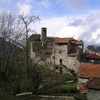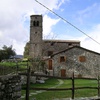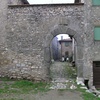Castle of Motrone
The mediaeval village of Motrone stands on a rocky outcrop called "Bucine" that overlooks the valley of the Turrite Cava river. The strategic location of this site allowed for direct visual contact with some of the main fortifications of the valley such as those of Cardoso, Vallico di Sopra and Coreglia.
Between the fifteenth and sixteenth centuries, the village was equipped with a defensive wall, turrets and a gateway, the only surviving element of the original defence system. Unfortunately nothing remains of the original fortress which belonged to the Suffredinghi: from some graphic representations, we know that it consisted of a rather massive square tower of plain construction.
Historical notes
In the "site" of "Mutrone" there was already a church dedicated to San Giusto in 995, assigned in 1062 to the family of Sigefredo Suffredinghi. It is probably at this time that the small community was fortified and equipped, given that in 1244 the "Castrum Motronis” was quoted by the Emperor Frederick II, who confirmed ownership by the Suffredinghi.
At the beginning of the fourteenth century, the complex of defensive works depended directly on the city of Lucca. The castle was always kept in good working order and became part of the County of Coreglia led by Francesco Antelminelli, in 1355, when it was numbered among the "castrums" of the Garfagnana in the Golden Bull written by Emperor Charles IV of Bohemia.
Despite its perched position, in 1429 the fort was attacked and conquered by Florentine troops captained by Niccolò Fortebraccio; from there they led other attacks directed against the castle of Gallicano and the "territories" of Vallico di Sopra and Vallico di Sotto. The fortification of Motrone, which returned to the hands of Lucca as a result of the peace treaties of 1442, again enhanced in its defences during the sixteenth and seventeenth centuries because of its position on the border between the State of Lucca and the Este. After the friction that ignited the tempers of the citizens of Lucca and the Estensi in the early seventeenth century, Motrone castle began to gradually lose tactical importance, so much so that over time it was demilitarised.











